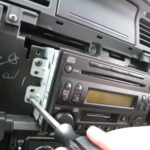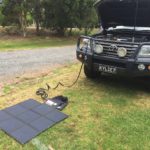Solar Charging Made Easy

Solar powered 12v electrical systems are the must have accessory in the RV scene today and for good reason. Prices have come down to a point where most people can afford to have a fairly comprehensive system installed on their RV allowing us to take our modern day appliances away with us anywhere we want. We can power them for extended periods of time without having to rely on 240v mains power. Also, we can start to reduce our reliance on noisy generators. Problem is so many people seem to have got themselves set up with what appears to be a quality system but they are finding, in real world use, it’s just not meeting their power requirements resulting in flat batteries and a fridge full of warm beer.
There is a heap of information on the internet about this subject, even on this site we have published some guidance and tools to assist with scaling your solar power systems, but many of these guides require people to have a good working knowledge of their systems right down to detailed specifications which can be confusing and difficult to find out. What’s needed is a very simple rule of thumb that anyone with just a basic understanding of 12v electrics can use to size up a solar battery system or see why their existing setup is failing to meet their needs.

Well after a bit of research and playing around with some spreadsheets, I think I’ve come up with a system that is easy to use, simple to understand and will give you a pretty good idea of what’s happening.
The first thing we need to do is to have the most basic understanding of the founding principle by which all electrical systems are bound. That is Ohm’s Law. This easy equation is the equivalent of Einstein’s famous E=MC2 when it comes to electronics. Ohm’s law is:
Watts = Volts x Amps
It cannot be any easier and once you’ve come to terms with this formula, the rest is relatively easy to understand. The reason this is so important is that almost everything to do with power generation and consumption can be expressed in Watts. Normally it’s stated in the specifications of a particular device or it can be calculated because Amps is also commonly stated in appliance specifications.
For the most part, and for the purposes of this discussion, Volts is always a constant 12v. So in order to make life simple for us, we will work things out almost exclusively in Watts.
Now, think about electricity as if it was water. We need to store it and plumb it around to our devices. We will consume it and, most importantly, we need to replenish it. In this way you can almost consider watts and being like litres of water in the electrical system. Your battery is like a big bucket of water, your wiring is the plumbing and all your 12v appliances are boiling your water away all at different rates. Your solar panels are like a pipe from your roof gutters at home feeding ‘free’ water back into your bucket.
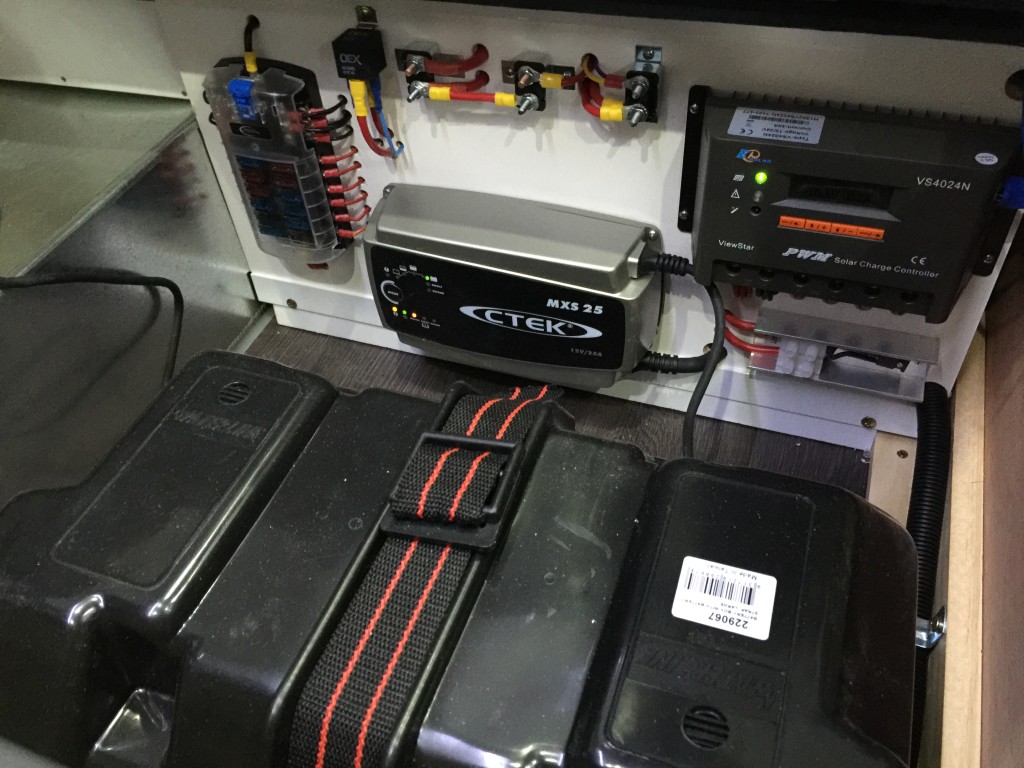
This process happens over time so, just as your tap has a flow of water in litres per minute, we need to consider electricity in much the same way. If a device, let’s say an LED light, is rated at 5 watts, expressed in terms of time, it simply consumes 5 watts per hour or 5 watt hours per hour.
Batteries are not rated in watts. They are rated in amps, or more precisely, amp hours. This is the amount of water that our electronic bucket can hold. If we have an electronic device that uses 1 amp per hour, and we run it from a single 100ah battery, theoretically, the battery will be completely flat in 100 hours. But we want to look at this in terms of watts. How do we do it? Remember ohms law? If watts = volts x amps, and our battery is rated in amp hours, it is simply 12 volts x 100 amp hours = 1200 watt hours. Our load of 1 amp, using the same formula, is 12 watts and over time is expressed as 12 watt hours. Run that load constantly and knowing we will consume 12 watt hours per hour, our 1200 watt bucket will be empty in 100 hours. Simple isn't it...?

Now, batteries, specifically lead acid batteries whether they be AGM, gel or wet cell, are delicate things. They do not like being drained below 40% of their total capacity or State of Charge (SOC). Some will argue you should never let them drain to less than 50% of their capacity. The exceptions to this 'rule' are Lithium batteries which can sustain a deeper discharge but given they are relatively new, expensive and very few manufacturers fit these as standard, we will leave them out of this article for now. For our purposes, we will say that we do not want to let our batteries drain to less than 50% SOC to prevent damaging them. So back to our example above, knowing this 50% rule, we cannot run the 12 watt load for longer than 50 hours (or just over 2 days) in order to prevent the battery from discharging below 50% SOC. You can start to see the problem we have and why so many people are experiencing difficulties with their 12v systems. It is all too easy to drain our batteries below this 50% level. If we do it once or twice over a battery's lifetime, is not too much of a drama, but do it several times and we will start to notice a decrease in battery performance. Some battery types cope better than others but, unless you know otherwise, its likely your van was supplied with basic lead acid batteries, so we'll keep to the 50% rule for now.
In order to resolve this we need to recharge our battery, or refill our bucket, and to do that we are going to use solar panels. Conveniently, these come rated in watts already. Now we know the sun doesn’t shine at a constant rate. Clouds, shadows and even the time of year can alter the amount of sunlight that falls onto our panels and rarely, if ever, do they actually produce the amount of electricity or watts they are rated at. Let’s just park that thought for a bit and come back to it later. For now, let’s assume we are working in a perfect world and we have a 100 watt solar panel and that is what it will produce if we place it in full sunlight. Expressed in time, that’s 100 watts hours per hour.
 Back to our 12 watt light that has been running for 50 hours. It has now reduced our battery capacity from 1200 watts hours to 600 watts hours. How much solar time do we need to replenish that power or ‘make back’ 600 watts we used? If we have a perfect sunny day and, under such conditions, our 100 watt solar panel produces 100 watts per hour, in 6 hours we will have fully recharged our battery. (6 x 100 watt hours = 600 watts) Seems very simple doesn’t it?
Back to our 12 watt light that has been running for 50 hours. It has now reduced our battery capacity from 1200 watts hours to 600 watts hours. How much solar time do we need to replenish that power or ‘make back’ 600 watts we used? If we have a perfect sunny day and, under such conditions, our 100 watt solar panel produces 100 watts per hour, in 6 hours we will have fully recharged our battery. (6 x 100 watt hours = 600 watts) Seems very simple doesn’t it?
Unfortunately it doesn't always work out like that in the real world, but for the purposes of understanding the underlying principles, this example is OK and will serve as the basis for the rest of this article.
Before I go on, I can hear the chorus of electronics experts out there who will, at this point, be screaming all sorts of technical jargon like ‘inefficiencies in the system’ and ‘power losses in different types of batteries’ and 'solar panels rarely if ever run at 100% capacity'. Some will also point out that if a solar panel runs at its peak performance in perfect conditions, it actually produces more than 12 volts. Depending on the quality of the panel, it can be as high as 20 volts...! That’s why we have solar regulators or controllers in our system. They magically turn this excess voltage into more amps. So I reckon for the purposes of making things simple, we can just assume that this additional power compensates for any system losses or inefficiencies.
What we need to do now is apply this knowledge to the real world. For instance, we know the sun doesn’t shine constantly all day. Also, just because we are charging our batteries during the day, our power usage doesn’t magically stop. We need to look at how we are drawing our power over a 24 hour period and how much solar charging we are actually likely to get during that time. We also need to be realistic about our actual power consumption needs. We are not simply running a single 12 watt light. We have fridges to run, TVs and DVD players, phones to charge up. Many of us may have to run a Cpap machine overnight. You may want to run a heater during the night, all these things consume power at varying rates depending on the time of day and the usage we require. To get a reasonably accurate idea of how our power will be consumed and how effective our solar recharging will be, we need to look at this in more detail.
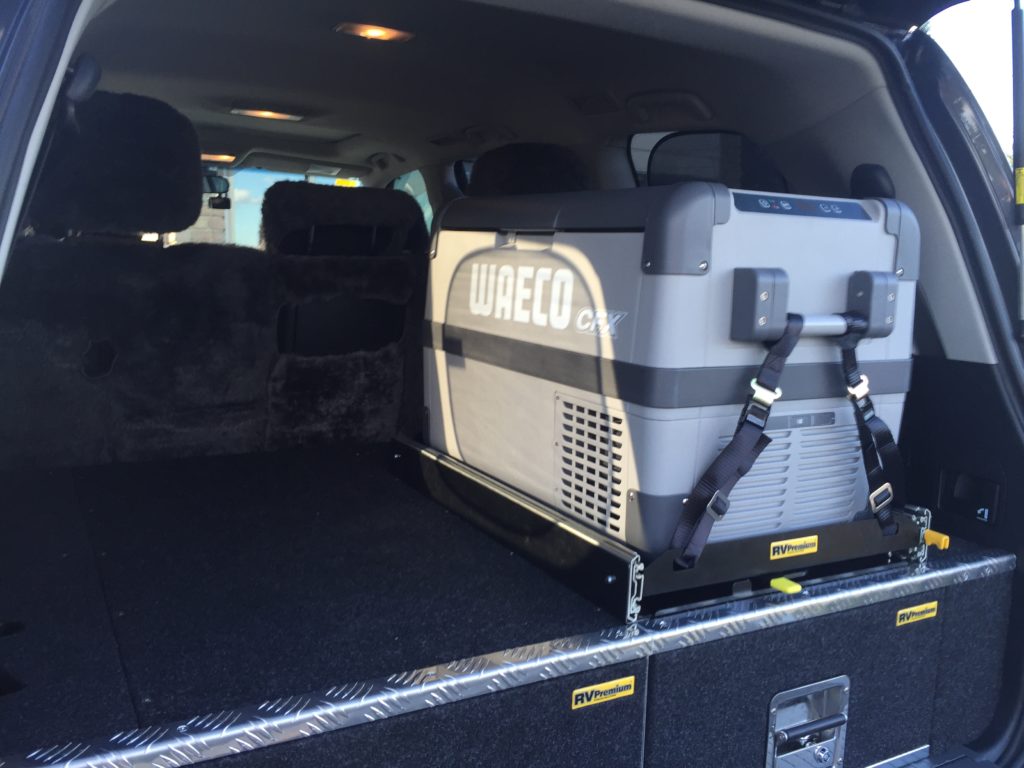
Most camper trailers and many caravans have 12v fridges and these are very power hungry devices but, despite being switched on all the time, the compressor that does the cooling work switches on and off depending on the temperature setting and the ambient weather conditions. If the weather is hot, they run more often. When it is cold, the workload is lessened and so the compressor doesn’t engage as often. This is called a duty cycle and many fridges will quote you an average duty cycle in their specifications, conveniently in watt hours. For the purposes of our exercise, we can reasonably assume that this duty cycle rate will be a constant during the period our fridge is turned on. Similarly, we don’t use our lights and TV constantly and we don’t need to use our Cpap machine during the day. All this means we need to consider what our typical power usage pattern may be using these devices intermittently. We can express this over a 24 hour period on a spreadsheet very easily. We just need to determine the power requirements of all our devices, estimate when we will use them and for how long, by adding up the watt hours for each individual device in use at that time and plotting that usage over the 24 hour period .
To give us a starting point, let’s consider a typical situation. We will list a variety of 12v electrical appliances and, by looking at their specifications, determine their power requirements. I’m going to use our caravan’s appliances which include a 240l compressor fridge/freezer, a 12v TV/dvd player, some LED lights, a couple of Iphone chargers and a cpap machine running without the humidifier. By looking at the specifications for each appliance, I have determined the power consumption as follows:
| Appliance | Power Consumption (Duty Cycle) | Time in use per day | Total Power Consumption per day |
| Compressor Fridge/Freezer | 55 Watt hours | 24 hours | 1320 watt hours |
| TV | 1 watt hour | 4 hours (6-10am) | 4 watt hours |
| LED lights | 30 watt hours | 4 hours (6-10pm) | 120 watt hours |
| 2 x iphone chargers | 1 watt hour | 4 hours (6-10pm) | 4 watt houts |
| Cpap machine no humidifier | 1 watt hour | 8 hours (11pm-6am) | 8 watt hours |
| TOTAL | 1,456 watt hours |
From this we can see that for most of the night, we will be consuming 56 watt hours per hour just running the fridge and the cpap machine. Then, when morning dawns, we reduce our power consumption by 1 watt hour per hour because the cpap machine is switched off but the fridge is still running. This remains constant until 6pm when our power needs rise dramatically when we are lighting up our campsite, charging our phones and watching a movie on the TV. Then we all go to bed at 11pm and our power consumption returns to the night time constant. Plotted on a graph it looks like this:
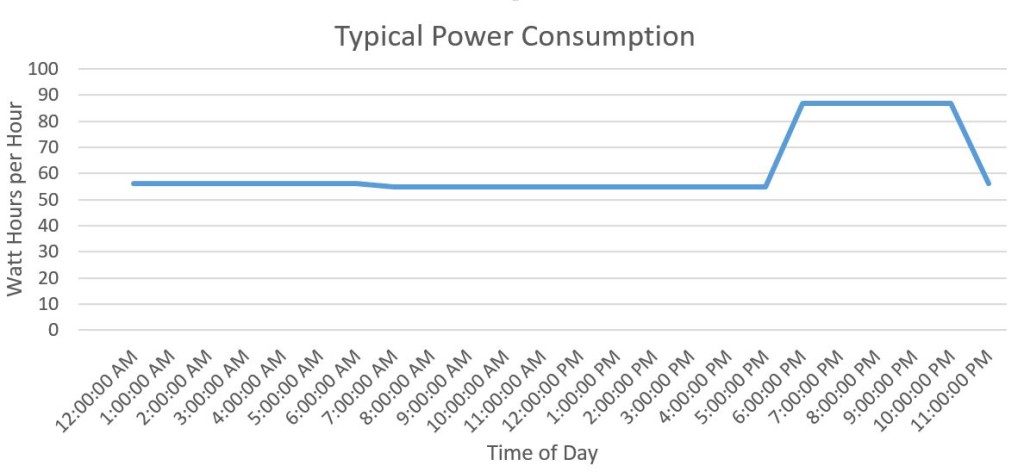
Now we need to look at how our battery will cope with this level of power consumption, without factoring in any charging at this stage. Let’s assume we have 2 x 100ah batteries giving us a total of 200ah or, as we know using Ohm’s Law, 2400 watt hours available in our ‘bucket’. The available power in our battery will drop over time as per the following graph:
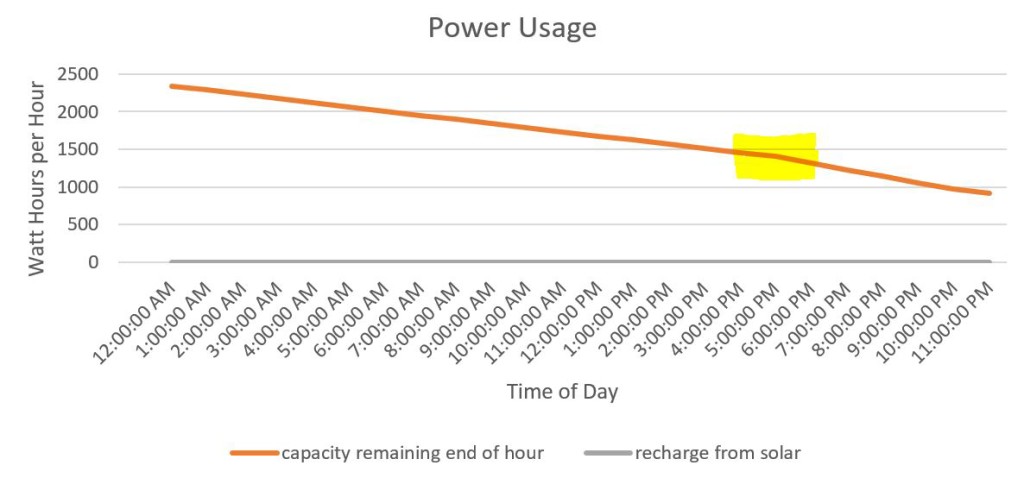
You can see how the capacity drops dramatically at 6pm (highlighted) when we start to use some serious power. If left without any charging during the day, we will have consumed 1,456 watt hours for the day and our battery will have been depleted to 944 watt hours, well below the 50% maximum discharge point. If we continued this without any solar charging, our batteries will be dead flat by 4pm the next day.
It becomes obvious why solar charging is so important so let's add some charging to the system. Again, knowing we will not get a constant 100% out of our solar panels all day, we need to make some assumptions about what we might typically expect to get. The sun is at its strongest during the middle hours of the day, say between 12pm and 1pm. In the hours before and after those times, its strength is considerably less. We need to make some estimates for how much sun we are likely to get and what hours we will have available. To be safe, and to give us some margin for error, let’s say that we won’t make any effective solar charge before 10am and not after 3pm. In between those hours we will make approximately 50% of our total solar capacity in the first 2 hours, then 100% capacity in the next two and then back down to 50% in the next 2 hours. The following chart shows what that may look like depending on the size of the solar panel(s):

Knowing we will have consumed 1,456 watt hours in the earlier example, we need sufficient solar capacity to make up at least that amount and according to the chart above, we will need a minimum of 400 watts of solar panels to do so. Our power consumption chart now looks like this:
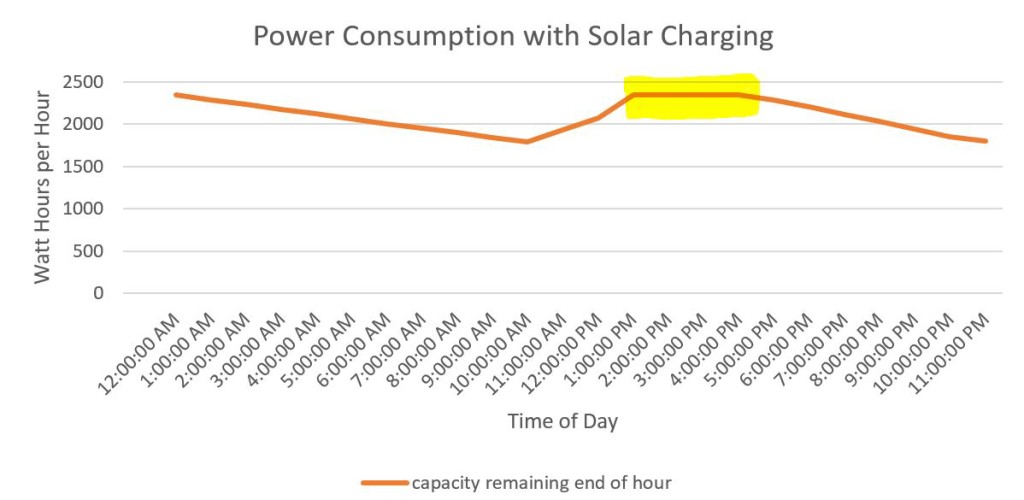
You’ll note that our battery capacity plateaus in the hours 12pm to 3pm at 2400 watt hours (highlighted). That is because we are producing more solar charge than we can store and our battery remains fully charged during that time. Having more solar panels will not necessarily change this. In other words, we cannot fill our bucket any more than it can hold. This is a real problem and one that is not well understood. If we were to increase our evening power consumption in this example, we run the risk of a power shortfall and just adding a few more solar panels will not necessarily fix that. If that turns out to be the case, it is likely we will need to increase our battery capacity in order to meet our power requirements.
Now all that is good in theory. How does all this work in the real world?
For a start, our Roadstar caravan has 450 watts of solar panels on the roof and even in the worst overcast conditions, and during the early/late hours of the day, they manage to produce enough power to put some charge into the batteries. If we can increase our solar capacity to these higher levels, we can start to consider the effect of additional charging at earlier and later hours of the day. These additional hours charging, particularily in the afternoon and evening, can make all the difference when it comes to keeping up with our daily power consumption.
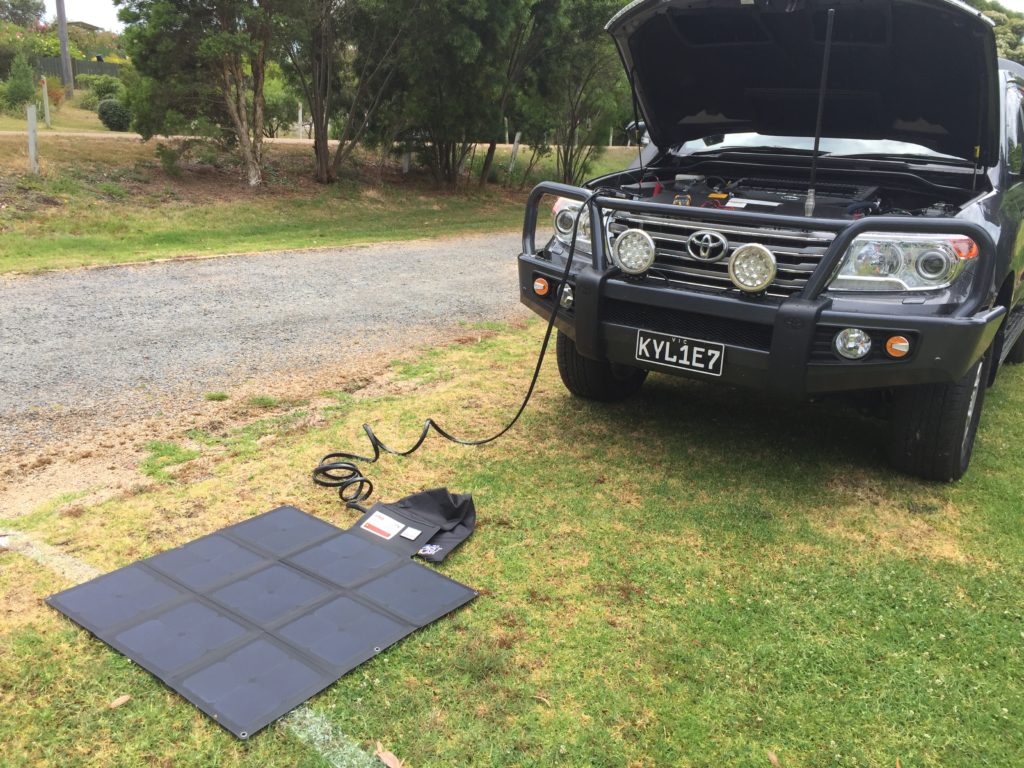
The other matter to consider is the location of our solar panels. Most caravans have them mounted on the roof. This is a great location for them as they can be functional when we are travelling down the road during the day. When we’re camped, we generally do not park fully out in the open. The reality is that we are more likely to camp under some tree cover. This has a dramatic effect on our solar panels’ ability to produce their maximum output. Some panels can be reduced by half again just because of tree cover.
A good solution to assist with both these issues is to have some solar panels that are external to our caravan/camper that can be placed in the full sun to compliment your roof mounted panels. With these external panels, you can ‘chase’ every last bit of sunlight available towards the end of the day and give your battereis every chance to cope with the evening and overnight load.
In summary, what can we take away from all this?
Well, there is probably not one simple rule of thumb that can be applied to every situation. But one thing is for sure. While battery capacity is important, your ability to recharge those batteries to a sufficient level before nightfall is extremely vital especially if you are running high power consumption devices for extended periods of time.
If you’re only going to run a couple of LED lights and perhaps a TV for a few hours a night, then you could probably cope with minimal battery capacity and a modest solar panel. Once you introduce a fridge, you will need bigger batteries and a lot more solar capacity. If your overnight power needs are high, you will want to be able to extract the maximum amout of solar charge time as you can and external panels will likely be necessary.
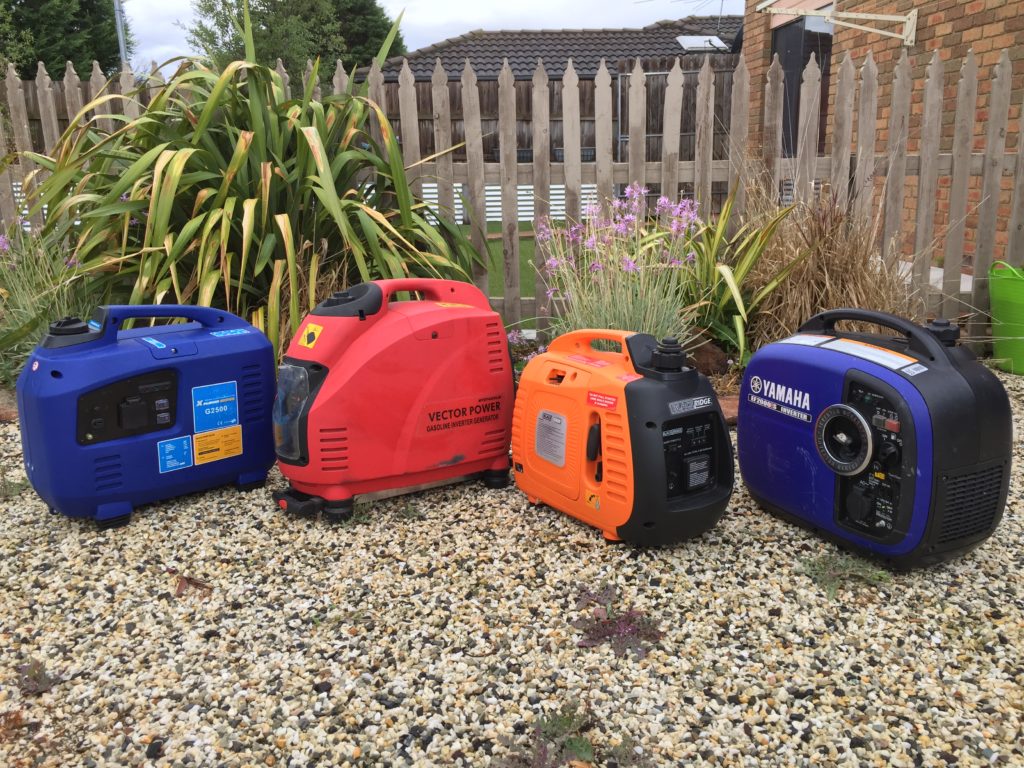
Finally, as much as we want to think that our solar system can sustain us indefinately, there is always the chance we have underestimated our requirements or we experience several days in a row of bad weather. If we are relying on our batteries to power fridges or medical equipment, it is prudent insurance to have a small generator and a 240v battery charger as an emergency backup.
Below is a table of what typical sized systems could be depending on the amount of power required. Again, this is not a be all and end all. This is a very rough guide.
| Appliance Load | Battery Capacity | Solar Capacity Fixed | Solar Capacity External | Generator Backup Required? |
| 20 watts LED lights, TV/DVD Combo and a iphone charger | 100 – 200 amp hours | 200 watts | 50 watts | Not essential |
| 30 watts LED lights, TV/DVD combo, 2 x iphone chargers, 50l car fridge | 200 – 300 amp hour battery | 200 watts | 80 watts | Possible |
| 40 watts LED lights, TV/DVD combo, 2 x iphone chargers, 230l compressor fridge/freezer, cpap machine | 200 – 400 amp hour | 400 watts – 500 watts | 100 - 200 watts | Yes definately |
One way to get access to additional battery power is to tap into your car’s auxiliary battery by plugging your van into the Anderson charging plug using an umbilical cord (pictured above) remembering this battery will likely charge independently of your van's batteries.
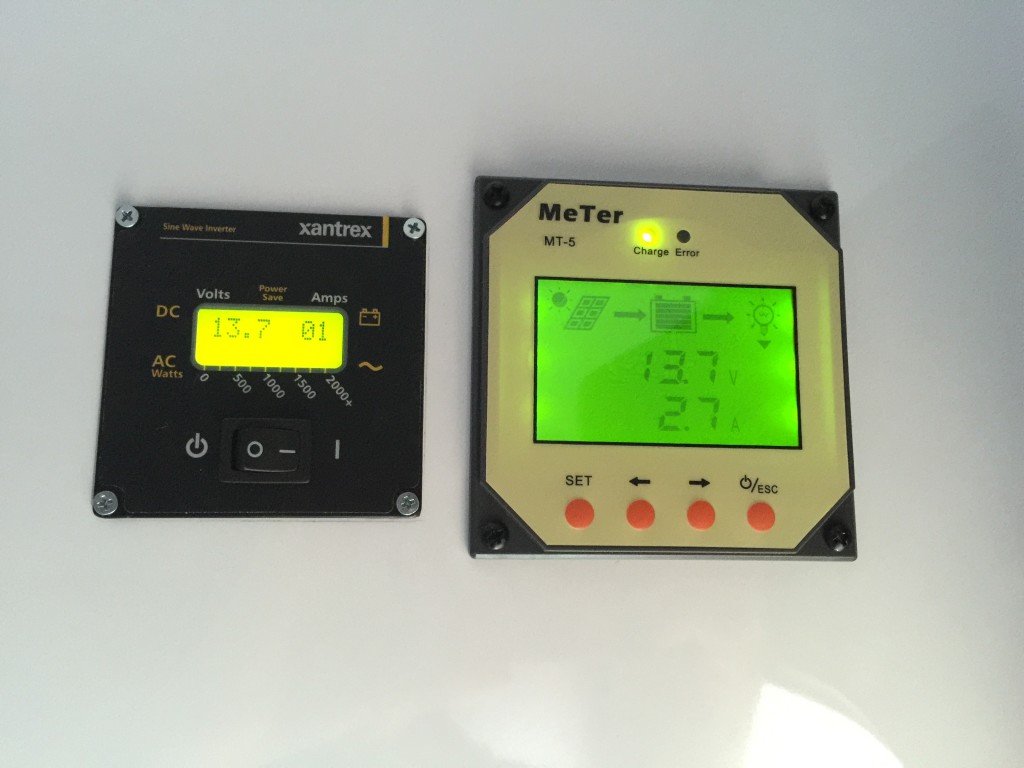
I also highly reccommend ensuring your 12 v system has sufficient monitoring so you can physically see the power going in and the power coming out of your batteries. At the very least, invest in a good quality multimeter and learn how to use it to measure the various voltages in your system.
Hopefully this gives you a good starting point from which you can size up a solar 12v system or gain an understanding of why your existing system isn't lasting as long as you thought it would. Please remember that we have made quite a lot of assumptions here for the sake of simplicity. I highly reccommend getting more familiar with the black art of 12v systems by talking to the experts and then deciding on a system that's right for your individual situation, especially if you have medical needs relying on your 12v system lasting the distance.
Safe travels.


